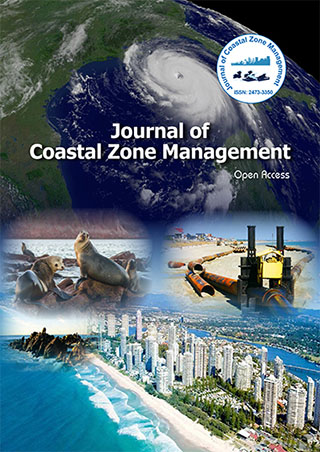Indexed In
- SafetyLit
- RefSeek
- Hamdard University
- EBSCO A-Z
- OCLC- WorldCat
- Publons
Useful Links
Share This Page
Journal Flyer

Open Access Journals
- Agri and Aquaculture
- Biochemistry
- Bioinformatics & Systems Biology
- Business & Management
- Chemistry
- Clinical Sciences
- Engineering
- Food & Nutrition
- General Science
- Genetics & Molecular Biology
- Immunology & Microbiology
- Medical Sciences
- Neuroscience & Psychology
- Nursing & Health Care
- Pharmaceutical Sciences
Perspective - (2025) Volume 28, Issue 2
Marine Spatial Planning for Sustainable Ocean Use and Resource Management
Amila Sandaruwan*Received: 30-Apr-2025, Manuscript No. JCZM-25-29426; Editor assigned: 02-May-2025, Pre QC No. JCZM-25-29426; Reviewed: 16-May-2025, QC No. JCZM-25-29426; Revised: 23-May-2025, Manuscript No. JCZM-25-29426; Published: 30-May-2025, DOI: 10.35248/2473-3350.25.28.678
Description
Marine Spatial Planning (MSP) is an increasingly important approach to managing the use of ocean space in a sustainable, efficient and equitable manner. It involves the systematic analysis and allocation of marine areas to balance competing human activities while preserving ecosystem health. As the demand for marine resources and space grows driven by shipping, fisheries, offshore energy, tourism and conservation needs, MSP provides a practical framework to reduce conflicts, improve governance and ensure long-term sustainability of marine environments.
The world's oceans support a wide array of ecological functions and human activities. Coastal and marine environments are home to rich biodiversity and provide vital ecosystem services, including carbon storage, climate regulation, nutrient cycling and food supply. At the same time, oceans are crucial economic zones supporting livelihoods, trade, transportation and energy production. Without proper planning, uncoordinated and overlapping uses can degrade marine ecosystems, reduce productivity and increase competition among users. MSP addresses these challenges by coordinating uses in space and time to optimize outcomes and minimize negative impacts.
The concept of MSP emerged in response to the growing complexity of marine use and the need for integrated decision-making. Unlike traditional sector-based management, which focuses on individual industries or issues, MSP takes a comprehensive view of the marine environment. It brings together stakeholders from various sectors, including fisheries, maritime transport, tourism, conservation and energy, to jointly develop plans that reflect shared goals and priorities. This participatory process ensures that the needs of diverse groups are considered and that decisions are grounded in transparency and inclusiveness.
A central goal of MSP is to support the sustainable development of marine resources. By identifying suitable areas for different uses such as fishing grounds, shipping lanes, marine protected areas and offshore wind farms, MSP reduces spatial conflicts and promotes efficient resource use. For example, allocating zones for renewable energy installations away from ecologically sensitive areas or heavily trafficked routes helps protect biodiversity and maintain safety at sea. Similarly, designating marine conservation areas can safeguard critical habitats and support fishery replenishment, contributing to long-term ecological and economic resilience.
MSP also plays a vital role in conserving marine ecosystems. Human pressures such as pollution, overfishing, habitat destruction and climate change have led to widespread degradation of marine environments. Through MSP, areas of high ecological value such as coral reefs, seagrass beds and breeding grounds can be identified and prioritized for protection or restoration. By integrating scientific data and traditional knowledge, MSP helps ensure that conservation efforts are grounded in the best available evidence and respect local cultural values and practices.
Another significant benefit of MSP is its role in supporting blue economy initiatives. The blue economy refers to the sustainable use of ocean resources for economic growth, improved livelihoods and ocean ecosystem health. MSP contributes to this by enabling smarter investment, reducing uncertainty and streamlining permitting processes for marine industries. Whether it is through planning aquaculture zones, developing coastal tourism infrastructure, or guiding marine mining, MSP provides clarity and predictability that attract responsible investors and promote environmental stewardship.
Climate change adds further urgency to the need for effective marine spatial planning. Rising sea temperatures, ocean acidification, sea-level rise and increased storm intensity threaten marine ecosystems and the communities that depend on them. MSP offers a tool to build resilience by incorporating climate risk into spatial decisions. For instance, it can guide the relocation of critical infrastructure, support the restoration of coastal habitats that buffer storm surges, or identify refuge areas for climate-sensitive species. By factoring in long-term environmental trends, MSP helps adapt marine management to a rapidly changing world.
Conclusion
Implementing MSP requires a strong foundation of data, governance and stakeholder engagement. Accurate and up-to- date spatial data on marine habitats, resource distribution, human activities and environmental conditions are essential for informed planning. Modern technologies such as satellite remote sensing, oceanographic modeling and Geographic Information Systems (GIS) enhance the ability to visualize and analyze complex marine systems. Robust legal and institutional frameworks are needed to enforce plans, monitor compliance and resolve disputes. Equally important is engaging stakeholders throughout the planning process to build trust, ensure legitimacy and promote shared response.
Citation: Sandaruwan A (2025) Marine Spatial Planning for Sustainable Ocean Use and Resource Management. J Coast Zone Manag. 28:678.
Copyright: © 2025 Sandaruwan A. This is an open-access article distributed under the terms of the Creative Commons Attribution License, which permits unrestricted use, distribution and reproduction in any medium, provided the original author and source are credited.
